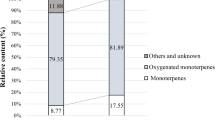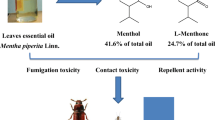Abstract
The essential oils (EOs) from aerial parts of Saussurea amara (L.) DC. (SAEO) and Sigesbeckia pubescens Makino (SPEO) were analyzed for their chemical composition by GC-MS, and their repellent activities against adults of the red flour beetle, Tribolium castaneum Herbst, as well as the booklouse, Liposcelis bostrychophila Badonnel, were evaluated for the first time. Results of GC-MS analysis indicated that both SAEO and SPEO were characterized by high content of sesquiterpenoids (relative content > 70%) including oxygenated sesquiterpenoids. The two oil samples and their major component caryophyllene oxide exerted beneficial repellent effects on T. castaneum and L. bostrychophila at 2 and 4 h post-exposure. At 4 h post-exposure, the PR value of caryophyllene oxide could still reach 92% (class V) against T. castaneum at minimum testing concentration of 3.15 nL/cm2, and this compound was observed to result in the greatest repellency (PR = 100%) against L. bostrychophila at 12.63 nL/cm2. This work confirmed the potent repellent efficacy of SAEO and SPEO for controlling pest damage and suggested their potential to be developed into botanical repellents.
Similar content being viewed by others
References
Abdullahi G, Muhamad R, Dzolkhifli O, Sinniah UR (2018) Damage potential of Tribolium castaneum (Herbst) (Coleoptera: Tenebrionidae) on cocoa beans: effect of initial adult population density and post infestation storage time. J Stored Prod Res 75:1–9
Adams RP (2001) Identification of essential oil components by gas chromatography/quadrupole mass spectroscopy. Allured, Carol Stream IL
Asgar E, Sendi JJ (2015) A review on recent research results on bio–effects of plant essential oils against major Coleopteran insect pests. Toxin Rev 43(2):1–16
Avdeeva E, Reshetov Y, Shurupova M, Zibareva L, Borisova E, Belousov M (2017) Chemical analysis of bioactive substances in seven siberian Saussurea species. Am Inst Phys Conf Ser 050001
Benelli G, Pavela R (2018) Repellence of essential oils and selected compounds against ticks—a systematic review. Acta Trop 179:47–54
Benelli G, Pavela R, Petrelli R, Cappellacci L, Santini G, Fiorini D, Maggi F, Sut S, Dall’Acqua S, Canale A, Maggi F (2018) The essential oil from industrial hemp (Cannabis sativa L.) by-products as an effective tool for insect pest management in organic crops. Ind Crop Prod 122:308–315
Chander H, Nagender A, Ahuja DK, Berry SK (1999) Laboratory evaluation of plant extracts as repellents to the rust red flour beetle, Tribolium castaneum (Herbst), on jute fabric. Int Pest Control 41(1):18–20
Chu SS, Jiang GH, Liu ZL (2012) GC–MS analysis of insecticidal essential oil of flowering aerial parts of Saussurea nivea Turcz. DARU J Pharm Sci 20(1):14
De Oliveira JL, Campos EVR, Bakshi M, Abhilash PC, Fraceto LF (2014) Application of nanotechnology for the encapsulation of botanical insecticides for sustainable agriculture: prospects and promises. Biotechnol Adv 32:1550–1561
De Oliveira JL, Campos EVR, Pereira AES, Pasquoto T, Lima R, Grillo R, De Andrade DJ, Dos Santos FA, Fraceto LF (2018) Zein nanoparticles as eco-friendly carrier systems for botanical repellents aiming sustainable agriculture. J Agric Food Chem 66(6):1330–1340
Facknath S, Kawol D (1993) Antifeedant and insecticidal effects of some plant extracts on the cabbage webworm, Crocidolomia binotalis. Int J Trop Insect Sci 14(5/6):571–574
Fiorini D, Molle A, Nabissi M, Santini G, Benelli G, Maggi F (2019) Valorizing industrial hemp (Cannabis sativa L.) by-products: Cannabidiol enrichment in the inflorescence essential oil optimizing sample pre-treatment prior to distillation. Ind Crop Prod 128:581–589
Gao X, Wei J, Hong L, Fan S, Hu G, Jia J (2018) Comparative analysis of chemical composition, anti–inflammatory activity and antitumor activity in essential oils from Siegesbeckia orientalis, S. glabrescens and S. pubescens with an ITS sequence analysis. Molecules 23(9):2185
Gautam K, Rao PB (2003) Insecticidal properties of some plants of family Asteraceae against Spilosoma obliqua. Indian J Entomol (India) 65(3):363–367
Gillij YG, Gleiser RM, Zygadlo JA (2008) Mosquito repellent activity of essential oils of aromatic plants growing in Argentina. Bioresour Technol 99(7):2507–2515
Guo SS, Wang Y, Pang X, Geng ZF, Cao JQ, Du SS (2019) Seven herbs against the stored product insect: Toxicity evidence and the active sesquiterpenes from Atractylodes lancea. Ecotoxicol Environ Saf 169:807–813
Hashem AS, Awadalla SS, Zayed GM, Maggi F, Benelli G (2018) Pimpinella anisum essential oil nanoemulsions against Tribolium castaneum—insecticidal activity and mode of action. Environ Sci Pollut Res 25:18802–18812
Howard RW, Lord JC (2003) Cuticular lipids of the booklouse, Liposcelis bostrychophila: Hydrocarbons, aldehydes, fatty acids, and fatty acid amides. J Chem Ecol 29:615–627
Isman MB, Grieneisen ML (2014) Botanical insecticide research: many publications, limited useful data. Trends Plant Sci 19(3):140–145
Jun-Hyung T, Jovel E, Isman MB (2016) Comparative and synergistic activity of Rosmarinus officinalis L. essential oil constituents against the larvae and an bnovarian cell line of the cabbage looper, Trichoplusia ni (Lepidoptera: Noctuidae). Pest Manag Sci 72(3):474–480
Jun-Hyung T, Jovel E, Isman MB (2017) Synergistic interactions among the major constituents of lemongrass essential oil against larvae and an ovarian cell line of the cabbage looper, Trichoplusia ni. J Pest Sci 90(2):735–744
Kanvil S, Jilani G, Saljoqi AUR, Hussain N, Anwar M (2006) Effects of plant extracts on oviposition and egg hatching of Tribolium castaneum Herbst (Coleoptera: Tenebrionidae). Sarhad J Agric 22(3):503–516
Liu ZL, Ho SH (1999) Bioactivity of the essential oil extracted from Evodia rutaecarpa Hook f. et Thomas against the grain storage insects, Sitophilus zeamais Motsch. and Tribolium castaneum (Herbst). J Stored Prod Res 35:317–328
Liu P, Liu XC, Dong HW, Liu ZL, Du SS, Deng ZW (2012a) Chemical composition and insecticidal activity of the essential oil of Illicium pachyphyllum fruits against two grain storage insects. Molecules 17(12):14870–14881
Liu ZL, He Q, Chu SS, Wang CF, Du SS, Deng ZW (2012b) Essential oil composition and larvicidal activity of Saussurea lappa roots against the mosquito Aedes albopictus (Diptera: Culicidae). Parasitol Res 110(6):2125–2130
López MD, Pascual-Villalobos MJ (2015) Are monoterpenoids and phenylpropanoids efficient inhibitors of acetylcholinesterase from stored product insect strains? Flavour Frag J 30(1):108–112
Nararak J, Sathantriphop S, Kongmee M, Mahiou-Leddet V, Ollivier E, Manguin S, Chareonviriyaphap T (2019) Excito–repellent activity of β–caryophyllene oxide against Aedes aegypti and Anopheles minimus. Acta Trop. https://doi.org/10.1016/j.actatropica.2019.05.021
Nguyen LT, Myslivečková Z, Szotáková B, Špičáková A, Lněničková K, Ambrož M, Kubíček V, Krasulová K, Anzenbacher P, Skálová L (2017) The inhibitory effects of β–caryophyllene, β–caryophyllene oxide and α–humulene on the activities of the main drug–metabolizing enzymes in rat and human liver in vitro. Chem Biol Interact 278:123–128
Pandey AK, Singh P, Palni UT, Tripathi NN (2013) Bioefficacy of plant essential oils against pulse beetles Callosobruchus spp. (Coleoptera: Bruchidae) in pigeon pea seeds with particular reference to Clausena pentaphylla (Roxb.) DC. Arch Phytopathol Plant Protect 46(12):1408–1416
Pavela R (2014) Acute, synergistic and antagonistic effects of some aromatic compounds on the Spodoptera littoralis Boisd. (Lep., Noctuidae) larvae. Ind Crop Prod 60:247–258
Pavela R (2015) Essential oils for the development of eco–friendly mosquito larvicides: a review. Ind Crop Prod 76(4):174–187
Pavela R, Benelli G (2016) Essential oils as ecofriendly biopesticides? Challenges and constraints. Trends Plant Sci 21(12):1000–1007
Sadeh D, Nitzan N, Chaimovitsh D, Shachter A, Ghanim M, Dudai N (2019) Interactive effects of genotype, seasonality and extraction method on chemical compositions and yield of essential oil from rosemary (Rosmarinus officinalis L.). Ind Crop Prod. https://doi.org/10.1016/j.indcrop.2019.05.068
Sarpietro MG, Sotto AD, Accolla ML, Castelli F (2015) Interaction of β-caryophyllene and β-caryophyllene oxide with phospholipid bilayers: differential scanning calorimetry study. Thermochim Acta 600:28–34
Sotto D, Maffei F, Hrelia P, Castelli F, Sarpietro MG, Mazzanti G (2013) Genotoxicity assessment of β–caryophyllene oxide. Regul Toxicol Pharmacol 66(3):264–268
Spochacz M, Chowański S, Walkowiak-Nowicka K, Szymczak M, Adamski Z (2018) Plant–derived substances used against beetles–pests of stored crops and food–and their mode of action: a review. Compr Rev Food Sci 17(5):1339–1366
Tabanca N, Bernier UR, Agramonte MN, Tsikolia M, Bloomquist JR (2016) Discovery of repellents from natural products. Curr Org Chem 20(25):2690–2702
Wang JL (2007) Studies on the chemical constituents of Saussurea kansuensis Hand.–Mazz. and chemosystematic study on Saussurea DC. Master’s Thesis, Northwest Normal University, Lanzhou, Gansu Province, China
Wang YF, Yang ZB, Sha J (2010) Study on components of essential oil from 3 species (6 populations) of Saussurea DC. of the eastern of the Qinghai–Tibet Plateau and their systematic significance. J Sichuan Univ (Nat Sci Ed) 47(3):649–654
Wang Y, Zhang LT, Feng YX, Guo SS, Pang X, Zhang D, Geng ZF, Du SS (2019) Insecticidal and repellent efficacy against stored-product insects of oxygenated monoterpenes and 2-dodecanone of the essential oil from Zanthoxylum planispinum var. dintanensis. Environ Sci Pollut Res. https://doi.org/10.1007/s11356-019-05765-z
Wu Y, Guo SS, Huang DY, Wang CF, Wei JY, Li ZH, Sun JS, Bai JF, Tian ZF, Wang PJ, Du SS (2017) Contact and repellant activities of zerumbone and its analogues from the essential oil of Zingiber zerumbet (L.) Smith against Lasioderma serricorne. J Oleo Sci 66(4):399–405
Funding
This project was supported by the Yunnan Expert Workstation (2018IC153).
Author information
Authors and Affiliations
Corresponding author
Additional information
Responsible Editor: Giovanni Benelli
Publisher’s note
Springer Nature remains neutral with regard to jurisdictional claims in published maps and institutional affiliations.
Rights and permissions
About this article
Cite this article
Li, ZH., Wang, Y., Sun, JS. et al. Repellent activities of essential oils rich in sesquiterpenoids from Saussurea amara (L.) DC. and Sigesbeckia pubescens Makino against two stored-product insects. Environ Sci Pollut Res 26, 36048–36054 (2019). https://doi.org/10.1007/s11356-019-06876-3
Received:
Accepted:
Published:
Issue Date:
DOI: https://doi.org/10.1007/s11356-019-06876-3




